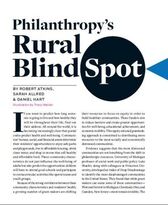How we're responding after a look in the (blind spot) mirror. Click to read the Stanford Social Innovation Review’s Spring 2021 Feature - Philanthropy's Rural Blind Spot Click to read the Stanford Social Innovation Review’s Spring 2021 Feature - Philanthropy's Rural Blind Spot The feature article of Stanford Social Innovation Review’s (SSIR’s) spring 2021 issue, Philanthropy’s Rural Blind Spot, made a clear and compelling case for why grant makers, even when focused on equity, have historically overlooked distressed suburban and rural communities in favor of their urban counterparts. While investing in densely populated, economically disadvantaged areas has often been regarded as the supposed “best bang for the buck”, the authors of the SSIR article made the case that this traditional system of funding leaves many communities across the country invisible, throwing equity out of the window. Interestingly, it is not just that funders are not paying attention to smaller communities, but also that many of the communities lack the human capital to apply and make the case for their own needs and innovative solutions. “…many smaller communities and organizations applying for grants experience a resource cost problem, wherein the administrative effort required to get a grant outweighs the value of the grant.”  Therefore, cities like Newark and Harlem, boasting high numbers of anchor institutions and non-profit organizations per capita, receive more funding than cities like Bridgeton and Flint, despite similar challenges. Conclusions of SSIR’s research run parallel to the findings captured in Pinnacle Prevention’s recently launched assessment report: Active Living in Arizona’s Rural Communities: A Call to Action. In 2019, with funding from the Vitalyst Health foundation, we interviewed and surveyed stakeholders across the state to gain a better understanding of how nonprofit and government agencies can work together with rural and tribal communities to improve opportunities for active living. Through the process, we heard that despite a phenomenon of crumbling infrastructure juxtaposed with a growing desire for safe recreation and transportation facilities, local staff in rural and tribal communities are stretched thin and lack the time to apply or even be aware of grant opportunities. Moreover, local champions lack the capacity to navigate complex grant applications on their own. As a result, local community members continue to lack access to safe places to play, gather, and relax. A stakeholder even asked that an organization step up to serve as a “Match.com” for funders and projects. Thankfully, last year, Pinnacle was also the recipient of a Vitalyst Health Foundation Systems Change grant to develop a collaborative effort focused on improving quality of life across the state through driving active living infrastructure investments into Arizona’s rural and tribal communities. The Plan of Action has been to:
2 Comments
|
Pinnacle Prevention BlogFollow our blog for tips, insights and conversations about healthy living. Archives
June 2024
Categories
All
|
Location |
|

